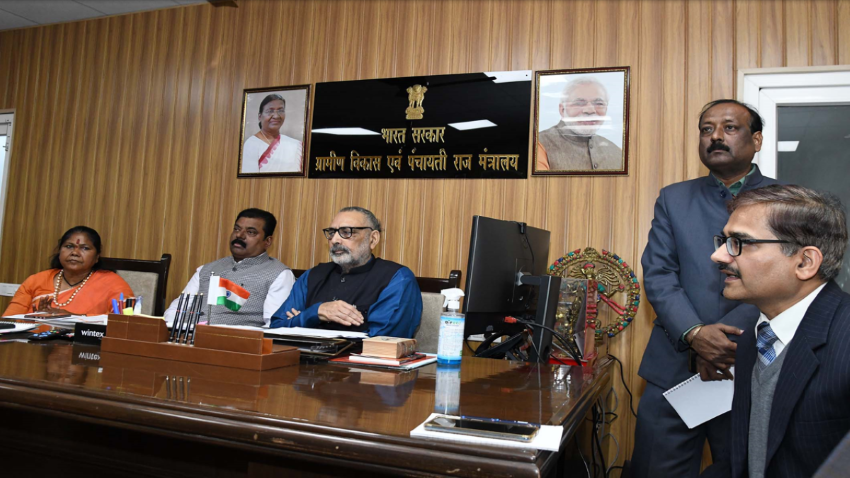
Inaugurating the Mission Antyodaya Survey (MAS) 2022-23 including the launching of its portal and mobile application at a function in New Delhi today, Giriraj Singh said, the Mission will ensure effective resource utilization through the convergence of various government schemes with a focused micro plan for sustainable livelihood for each marginalized household. He said that this has been done to underline the philosophy of Prime Minister Modi of the “Whole of Government Approach”.
The event was attended by Faggan Singh Kulaste, Minister of State for Rural Development and Steel; Sadhvi Niranjan Jyoti, Minister of State for Rural Development and Consumer Affairs, Food & Public Distribution; and Kapil Moreshwar Patil, Minister of State for Panchayati Raj. The event was also attended, through virtual mode by Ministers from States / UTs, and Senior officers.
According to Giriraj Singh, the scheme's other objectives include conducting an annual survey at the Gram Panchayat level to monitor progress in the development process in rural areas, ranking Panchayats based on data collected through the survey at the Gram Panchayat level, and producing a gap report. He went on to say that the Gap Report is an important input for the Gram Panchayat Development Plan (GPDP).
Giriraj Singh informed that Mission Antyodaya Survey 2022-23 Survey will be conducted in all 2,69,253-gram panchayats and equivalent, whose profile has been created on e-Gram Swaraj. However, Tripura, Meghalaya, and Nagaland are not covered yet due to elections.
The Survey-2022 Questionnaire has 183 indicators and 216 data points covering 21 areas. The 21 sectors being covered in the M A Survey are: (i) good governance; (ii) agriculture and land development, fuel, and fodder; (iii) animal husbandry; (iv) fisheries; (v) rural housing; (vi) water and environmental sanitation; (vii) roads and communications; (viii) conventional and non-conventional energy; (ix) financial and communication infrastructure; (x) markets and fairs; (xi) the Public Distribution System; (xii) library; (xiii) recreation and sports; (xiv) education/vocational education; (xv) health, nutrition, maternal and child development and family welfare; (xvi) welfare of weaker sections; (xvii) poverty alleviation program; (xviii) Khadi, village and cottage industries; (xix) social forestry; and (xx) Small scale industries.
Since 2017-18, the Department of Rural Development has been conducting Mission Antyodaya Survey across all Gram Panchayats in the country with the goal of transforming people's lives and livelihoods through the convergence of various schemes. An important component of the Mission Antyodaya framework is an annual survey in Gram Panchayats across the country.
According to Shailesh Kumar Singh, Secretary of Rural Development, the survey aims to support the process of participatory planning for the Gram Panchayat Development Plan (GPDP), which will improve service delivery, enhance citizenship, set the stage for an alliance of people's institutions and groups, and improve governance at the local level.
The creation of GPDPs is a comprehensive process that involves the use of both primary and secondary data to create the final plan document for any GP. The MA Survey provides secondary data for gap analysis, and the data will also be used to prepare block and district plans. The village-wise survey is expected to be conducted over a period of one month involving Community Resource Persons (CRPs). The survey questions have been categorized into five stratums: (i) Panchayat Infrastructure; (ii) Panchayat Services; (iii) Village Infrastructure; (iv) Village Services; and (v) Village Practices.
For the finalization of the questionnaire, 26 Central Government Ministries/Departments were consulted. The survey has been translated into 13 regional languages. In collaboration with NIC-DRD, the Ministry created an Android mobile application with a geo-tag feature for 36 assets in villages. The Ministry has also established an in-house Help Desk to handle questions about the questionnaire and mobile application.
Giriraj Singh concluded that India is a signatory to the United Nations' Sustainable Development Agenda 2030, which includes the adoption of 17 Sustainable Development Goals (SDGs). SDGs are not only an international obligation but also a means for all signatory countries to reorient their domestic expenditure priorities.
The fact that measuring progress on the goals will require quality, reliable, and disaggregated data is also underlined by the UN to ensure that "no one is left behind".
















